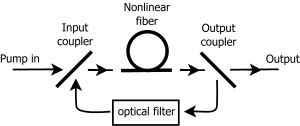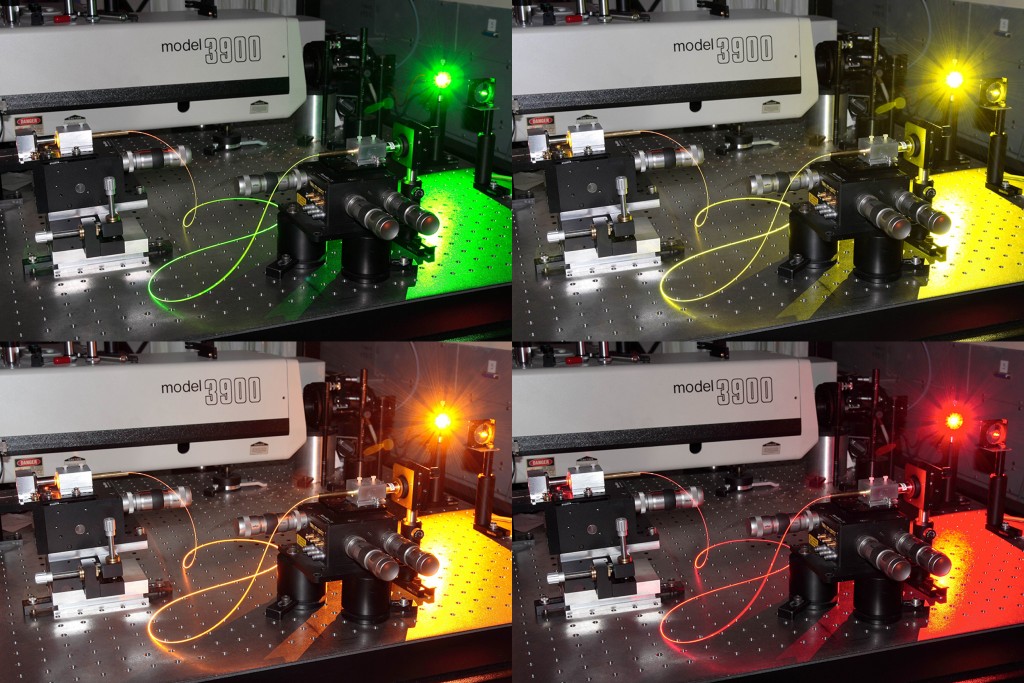Fiber optical parametric oscillators are based on the chi(3) nonlinearity of optical fibers rather than the chi(2) nonlinearity of traditional crystal based parametric oscillators. The schematic diagram of a typical fiber oscillator is shown in Fig. 1.

Fig 1: Schematic diagram of a singly-resonant ring optical fiber parametric oscillator.
The pump is input into the ring via an input coupler and coupled into the nonlinear fiber. The nonlinearity of the fiber allows parametric amplification of optical sidebands at the phasematched detuning. This detuning is set by the nonlinearity and dispersion of the fiber, and the wavelength and power of the optical pump. The output of the fiber passes through an output coupler to allow a set fraction of the output to exit the ring. The remaining light is passed through an optical filter. This optical filter transmits, and filters if necessary, only one of the sidebands. This ensures that the oscillator is singly-resonant. As with a conventional chi(2) oscillator, operating a fiber oscillator singly-resonant allows for stable output without requiring an interferometric stabilization of the cavity length. The resonant sideband is recombined with the input pump via the second port of the input coupler to close the ring. If a pulsed pump is used the round-trip time of the resonant sideband must be synchronized to the repetition rate of the pump. The input coupler used is typically dichroic so that the pump and the resonant sideband can be recombined without significant loss.
Many different fiber oscillator designs have been explored in my lab including:
- A widely tunable fiber oscillator based on standard telecommunications fiber and a C-band optical pump. This oscillator could be continuously tuned from 1300nm to 1840nm with typical optical bandwidth for the output sidebands of less than 1nm.
- A high conversion efficiency oscillator with an internal conversion efficiency of over 90% and an external conversion efficiency (sideband power out/pump power in) of 68%.
- A high power fiber oscillator with average output power of the parametric sidebands in excess of 2W per sideband over a continuous tuning range of ±25THz.
- A Fabry-Perot photonic crystal fiber parametric oscillator pumped by a ps TiS laser around 700nm. This oscillator produced a continuously tunable output in visible from 510nm to 687nm. This represents a maximum parametric frequency shift of 164 THz. The corresponding infra-red parametric sideband was continuously tunable from 768 nm to 1150 nm. Photos of this oscillator operating at 550, 570, 590 and 620 nm are shown below.

Fig 2: Fabry-Perot photonic crystal fiber oscillator operating at 550, 570, 590, and 620 nm.
For more details on this work please see:
Y. Q. Xu and S. G. Murdoch, “High conversion efficiency fiber optical parametric oscillator,” Optics Letters 36, 4266-4268 (2011)
Y. Q. Xu, K. F. Mak, and S. G. Murdoch, “Multiwatt level output powers from a tunable fiber optical parametric oscillator,” Optics Letters 36, 1966-1968 (2011)
Y. Q. Xu, S. G. Murdoch, R. Leonhardt, and J. D. Harvey, “Raman-assisted continuous-wave tunable all-fiber optical parametric oscillator,” J. Opt. Soc. Am. B 26, 1351-1356 (2009)
Y. Q. Xu, S. G. Murdoch, R. Leonhardt, and J. D. Harvey, “Widely-tunable photonic crystal fiber fabry-Perot optical parametric amplifier”, Optics Letters 33 1351-1353 (2008)
G. K. L. Wong, S. G. Murdoch, R. Leonhardt, J. D. Harvey, and V. Marie, “High-conversion-efficiency widely-tunable all-fiber optical parametric oscillator,” Optics Express 15, 2947-2952 (2007)